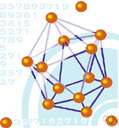molecular weight
n.
The sum of the atomic weights of all the atoms in a molecule. Also called relative molecular mass.
American Heritage® Dictionary of the English Language, Fifth Edition. Copyright © 2016 by Houghton Mifflin Harcourt Publishing Company. Published by Houghton Mifflin Harcourt Publishing Company. All rights reserved.
molecular weight
n
(Chemistry) the former name for relative molecular mass
Collins English Dictionary – Complete and Unabridged, 12th Edition 2014 © HarperCollins Publishers 1991, 1994, 1998, 2000, 2003, 2006, 2007, 2009, 2011, 2014
molec′ular weight′
n.
the average weight of a molecule of an element or compound measured in units based on 1/12 the weight of the carbon-12 atom; the sum of the atomic weights of all the atoms in a molecule. Abbr.: mol. wt.
[1875–80]
Random House Kernerman Webster's College Dictionary, © 2010 K Dictionaries Ltd. Copyright 2005, 1997, 1991 by Random House, Inc. All rights reserved.
molecular weight
The sum of the atomic weights of the atoms contained in a molecule. For example, since the atomic weight of hydrogen is 1 and the atomic weight of oxygen is 16, the molecular weight of water (H2O) is 1 + 1 + 16, or 18.
The American Heritage® Student Science Dictionary, Second Edition. Copyright © 2014 by Houghton Mifflin Harcourt Publishing Company. Published by Houghton Mifflin Harcourt Publishing Company. All rights reserved.
ThesaurusAntonymsRelated WordsSynonymsLegend:
| Noun | 1. |  molecular weight - (chemistry) the sum of the relative atomic masses of the constituent atoms of a molecule molecular weight - (chemistry) the sum of the relative atomic masses of the constituent atoms of a moleculemass - the property of a body that causes it to have weight in a gravitational field chemical science, chemistry - the science of matter; the branch of the natural sciences dealing with the composition of substances and their properties and reactions |
Based on WordNet 3.0, Farlex clipart collection. © 2003-2012 Princeton University, Farlex Inc.